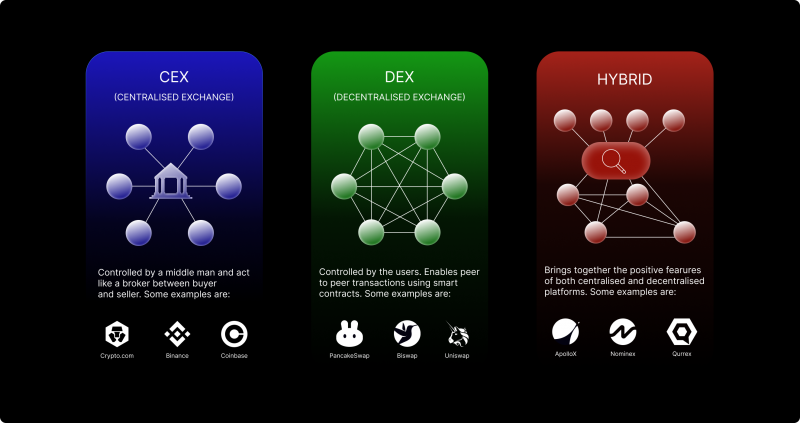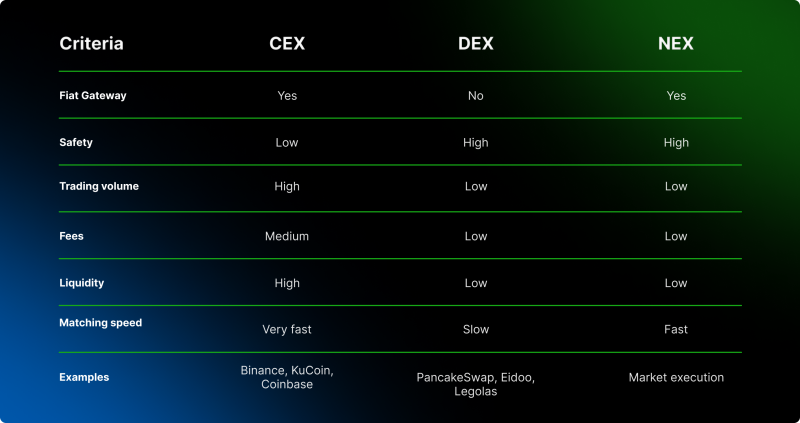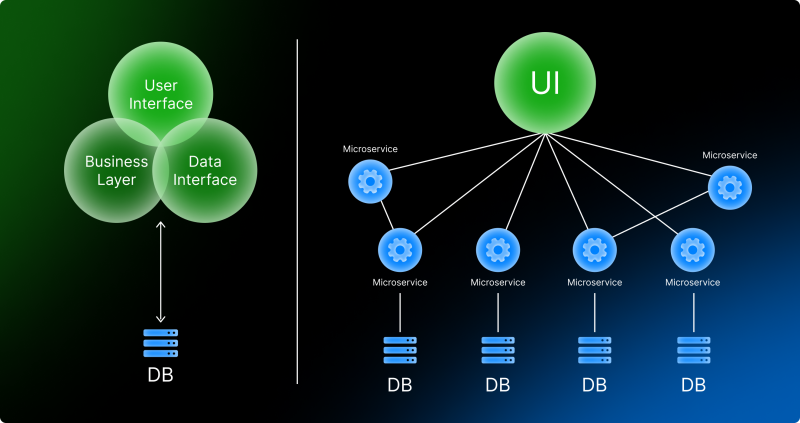How to Create a Crypto Exchange?

In today’s market environment, blockchain technology and cryptocurrencies are becoming increasingly popular and integral to social and economic processes. Today, few people can be surprised by such concepts as NFT, Metaverse, DeFi, or meme coins. The active introduction of blockchain technology and the popularization of cryptocurrencies leads to the fact that more and more people have become interested in making money on this premise.
Cryptocurrency exchanges, being online platforms that act as an intermediary among sellers and buyers in such trading operations as sale, purchase, and exchange between virtual and fiat money, have now become one of the most profitable types of business that brings enormous income. Today, almost every user who has learned about the existence of digital money seeks to understand how to become a crypto investing guru and multiply their capital. But more and more often, competent managers and advanced businessmen think about launching their own cryptocurrency exchange from scratch to cover their expenses and get impressive profits at once.
This article will shed some light on what types of crypto exchanges exist today, why elements like architecture, technology stack, and API play a key role in creating an exchange, and what features it must have to work correctly. In the end, you will find a step-by-step guide to help you start your own crypto exchange.
Types of Crypto Exchanges

To date, there are three types of crypto exchanges: centralized, decentralized and hybrid. All of them have their own features and differ in that they provide different functionality for trading. Let’s consider each of these types in detail.
1. Centralized Exchanges (CEX)
Centralized crypto exchanges (CEX) are specialized platforms for buying and selling cryptocurrencies that take place within the platform itself. The most important feature of a centralized exchange is the way it functions. Centralized exchanges are created and controlled by a certain group of people. Most trading platforms function this way, even outside of the crypto market. A large team or organization is fully responsible for the operation of such exchanges. This means that the management core of the exchange is one center, which manages absolutely everything.
Centralized exchanges are based on centralized finance (CeFi) concepts, which have been used for decades in traditional finance and stock exchanges. This integration of concepts leads to an exchange that offers the best of both worlds — a foundation of tried and trusted traditional CeFi and access to various next-generation cryptocurrencies.
2. Decentralized Exchanges (DEX)
Decentralized (DEX) cryptocurrency exchanges are platforms that allow the exchange of digital assets, operating within the DeFi Ecosystem (decentralized finance). They work on the principle of decentralization without the involvement of a central government. Decentralized exchanges allow cryptocurrencies to be traded peer-to-peer, directly between investors. For this reason, users do not need to transfer their assets to the exchange, reducing the risk of possible theft or hacking of the exchange server. Decentralized trading also prevents trading fraud or price manipulation.
To maintain decentralization, DEX uses smart contracts and algorithms to determine cryptocurrency prices. Liquidity pools (LPs), in which investors place their assets in exchange for rewards, are also used to facilitate transactions. Like many of DeFi’s products, DEX is built with a bias toward innovation and development. For this reason, they are primarily made on open-source code, which means anyone can adapt the code to create new competitive projects. This led to the creation of exchanges such as Uniswap, which in turn led to the Pancakeswap and Sushiswap projects emerging.
3. Hybrid Exchanges (HEX)
A hybrid exchange (HEX) is a semi-differentiated order negotiation protocol. All incoming orders and transactions are encrypted, time-stamped, and stored in a blockchain, and order matching is performed offline. Decentralization of order and trade information enables transparent pricing and transaction reliability. Centralization of the order pool and matching allows for scalability without restrictions or blocking. Developers of such exchanges provide high throughput through order pooling and matching.
By their idea, hybrid exchanges are the golden mean, combining the positive aspects of centralized exchanges, such as cooperation with large investors, trust from many users, and the positive sides of decentralized exchanges: reliable storage and no subordination body. The developers of this type of exchange strive to implement their ideas and become full-fledged players in the cryptocurrency market, and there are all the prerequisites for successful implementation.
The table below provides a comparative analysis of exchanges based on different criteria.

Architecture, Technology Stack and API of The Crypto Exchange

The creation of any cryptocurrency exchange involves the choice of architecture, technology stack, and API. Let’s take a closer look at what these things are.
Have a Question About Your Brokerage Setup?
Our team is here to guide you — whether you're starting out or expanding.
Architecture
Functionally, a cryptocurrency exchange is expected to do nothing more than connect buyers and sellers. This can be achieved using different architectures.
1. Monolithic Architecture
Monolithic architecture is a traditional model for cryptocurrency exchange software, a single module that runs autonomously and independently of other applications. A monolithic architecture is a separate large computing network with a single code base that integrates all tasks. The big advantage of a monolith is that it is easier to implement than other architectures. In a monolithic architecture, you can quickly start implementing your logic instead of spending time thinking about inter-process communication.
2. Microservice Architecture
A microservice architecture is a method of organizing a crypto exchange creation based on several independently deployable services. These services have their own logic and database with a specific purpose. Updating, testing, deployment, and scaling are done within each service. Microservices break down large process-specific tasks into multiple independent code bases. Microservices don’t reduce complexity, but they make any complexity visible and more manageable.
Technology Stack
Creating a cryptocurrency exchange is a complex process involving many stages where you need to consider different factors. In order to build the backbone of the exchange, it is necessary to develop the frontend and backend.
Frontend
A crypto exchange’s frontend is everything the end-user sees and can interact with. Creating this visual part is called frontend development. For frontend development, the basic tools used are HTML (to create basic page structure and content), CSS (to style the look and feel), and JavaScript (to add interactivity).
Backend
The backend is the server side of an exchange, hidden from the user’s eyes. It includes the servers that host the web pages and certain logic that controls the functions and processes of the site. For the backend, you can use any tools available on the server. In fact, you can use any universal programming language: Ruby, PHP, Python, Java, JavaScript / Node, bash.
API
The API technology on a cryptocurrency exchange allows receiving actual information about digital currencies and their prices from platforms such as TradingView, Coinmarketcap, or others. In particular, it can be information about the current price of a particular cryptocurrency, data about the volume of trading, historical data about the trading of certain cryptocurrencies, news feeds reflecting the situation on the cryptocurrency market, etc.
Must-Have Features for The Crypto Exchange Operation
The work of any cryptocurrency exchange includes a number of important aspects that must be taken into account before you start. Below is a list of the features that are necessary for the operation of a cryptocurrency exchange.
1. Liquidity
Liquidity is one of the most important aspects of any exchange, including cryptocurrency exchange, which indicates the “sellability” of an asset. Simply put, liquidity reflects changes in the market price that are caused by the fulfillment of an exchange order to buy or sell a certain size. In a perfectly liquid market, it would be possible to sell any amount of an asset at the same price without affecting it.
2. Matching Engine
A matching engine is the core of a cryptocurrency exchange that connects buyers and sellers, determining the cryptocurrency exchange’s speed and performance. As a result of continuously monitoring the order book for incoming orders, the order-matching engine provides order-matching services. As soon as an order is received, the engine attempts to match it against another order from the book. An order with no matching orders will be placed in the order book and matched when another order arrives. A trade will be executed upon finding a match, notifying both parties.
3. Admin Panel
The admin panel is the control center of a cryptocurrency exchange. The owner or administrator must have access to all important functions and be able to perform key actions, including user management, wallet and transaction management, as well as additional actions such as KYC and AML controls. If necessary and depending on the size of the exchange — you can even delegate roles to other users with limited authority.
4. Cryptocurrency Wallets
For users to store traded assets on the exchange, they need a crypto wallet. A wallet consists of a cryptocurrency wallet and a fiat wallet. This allows a blockchain to be linked to the deposit and withdrawal functions of the traded currencies. There are different ways to integrate the wallet with the underlying banking system. In manual mode, it can be direct bank transfers, and in automatic mode, you can use Visa or MasterCard services, where money is deposited directly into your bank account.
5. Order Book and Transaction History
Virtually every exchange in the world that trades cryptocurrencies or other digital assets has an order book for each of the markets available on the exchange. An order book is simply a list of pending buy and sell orders that traders place in exchange for a particular asset. In other words, the order book records the interest of buyers and sellers in a particular asset. This element, as well as the transaction history, is one of the most important when creating a crypto exchange.
6. User Interface
It should be recognized that the end-user does not really care about the subtleties of coding. What matters to them is a pleasant and intuitive interface. This interface is the first thing that attracts the user’s attention. At the same time, the growing number of smartphone users obliges the website to be compatible with mobile devices. Perhaps, in the beginning, it is optional to create mobile applications. Still, over time, it is necessary to make them available on the two major mobile operating systems — iOS and Android.
Development of Cryptocurrency Exchange – Ultimate Guide
Now that you know what crypto exchanges are, what their inner shell is, and what functionality a crypto exchange should have, it’s time to find out what is needed in order to launch your own crypto exchange. Are you ready? Let’s get started!
1. Market Research and Identification of the Target Audience
First, you need to consider how wide your target audience should be — it may be limited to one country and its jurisdiction. Still, it will be a different story if you plan to make your business global from the very beginning. In the latter case, you will need to take care of all the necessary international licenses and permits according to the laws of the countries where you plan to present your business. In either case, you will need the help of a lawyer experienced in dealing with international laws concerning exchanges.
2. Budgeting
You need to calculate the budget for the development of a crypto exchange. This includes hiring a team of developers, designers, and other specialists. This also includes the cost of buying web hosting space, installing security software, and other resources needed to launch the exchange. You should also look into budget-saving techniques because the process of creating a crypto exchange requires careful planning of every detail. Any miscalculation in financial planning can result in significant losses in the future.
Discover the Tools That Power 500+ Brokerages
Explore our complete ecosystem — from liquidity to CRM to trading infrastructure.
3. Website Development
Developers are now focused on putting user interface design into practice. They make the user-facing portion of your communication visible. Back-end development is ongoing simultaneously, including building the website’s code, protecting it, and interacting with the database. Currently being developed is a unique trading engine. When the backend and user interface are connected, the frontend phase begins.
4. License and Legal Nuances
At this stage, it is necessary to study all the legal aspects of the licensing of crypto exchanges. Most reputable cryptocurrency exchanges now operate under the supervision of financial regulators. Make sure that all the requirements from the regulator are met. A license will be required for all jurisdictions.
In addition, exchanges are obliged to implement AML (Anti-Money Laundering), a system to combat money laundering. The rules may differ from jurisdiction to jurisdiction. Therefore, it is essential to thoroughly understand this issue by consulting a lawyer who understands the specifics of this sphere of activity.
5. Product Testing
Usability testing is essential to creating an exchange because it lets you know if your exchange is being used by customers the way you want it to be. It also shows whether or not there are any problems with your exchange. This testing should be done as early as possible so that any design changes can be made before you launch the final version of your product.
After completing the software development and following the above steps, you need to ensure that your exchange works at a high level in the beta version. The experience of the site’s first users should be transferred to the developers to analyze and make changes so that the result can be a full launch of the project. Beta-testing is often conducted in closed mode. In addition, it can be used as an info-opportunity to promote the crypto exchange among the target audience.
6. Phase of Launching
When all the bugs are fixed, it’s time to launch the product. In most cases, this involves coding the backend to be ready to go live. At this stage of development, ensure all features are thoroughly tested before you launch your crypto exchange. You’ll need to create all the features the exchange needs and ensure they work well together and don’t create problems with each other or with other site elements, such as security features or payment options.
Conclusion
When answering the question of how to create a crypto exchange, you need to understand that this process is directly related to your resources to stay in the market and your knowledge of crypto and blockchain technologies. All of the above must be in sync with proper marketing planning, which can turn a new crypto-exchange development project into a successful venture. Successfully managing a crypto exchange and making it self-sustaining is not just a money issue but a combination of all the typical business elements. With a group of qualified and experienced professionals, you can make your dream crypto exchange a successful and prosperous business.




